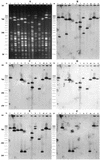Phylogenetic analysis and prevalence of urosepsis strains of Escherichia coli bearing pathogenicity island-like domains
- PMID: 12011017
- PMCID: PMC128014
- DOI: 10.1128/IAI.70.6.3216-3226.2002
Phylogenetic analysis and prevalence of urosepsis strains of Escherichia coli bearing pathogenicity island-like domains
Abstract
We characterized 100 Escherichia coli urosepsis isolates from adult patients according to host compromise status by means of ribotyping, PCR phylogenetic grouping, and PCR detection of papG alleles and the virulence-related genes sfa/foc, fyuA, irp-2, aer, hly, cnf-1 and hra. We also tested these strains for copies of pap and hly and their direct physical linkage with other virulence genes in an attempt to look for pathogenicity islands (PAIs) described for the archetypal uropathogenic strains J96, CFT073, and 536. Most of the isolates belonged to E. coli phylogenetic groups B2 and D and bore papG allele II, aer, and fyuA/irp-2. papG allele II-bearing strains were more common in noncompromised patients, while papG allele-negative strains were significantly more frequent in compromised patients. Fifteen ribotypes were identified. The three archetypal strains harbored different ribotypes, and only one-third of our urosepsis strains were genetically related to one of the archetypal strains. Three and 18 strains harbored three and two copies of pap, respectively, and 5 strains harbored two copies of hly. papGIII was physically linked to hly, cnf-1, and hra (reported to be PAI II(J96)-like genetic elements) in 14% of the strains. The PAI II(J96)-like domain was inserted within pheR tRNA in 11 strains and near leuX tRNA in 3 strains. Moreover, the colocalized genes cnf-1, hra, and hly were physically linked to papGII in four strains and to no pap gene in three strains. papGII and hly (reported to be PAI I(CFT073)-like genetic elements) were physically linked in 16 strains, pointing to a PAI I(CFT073)-like domain. Three strains contained both a PAI II(J96)-like domain and a PAI I(CFTO73)-like domain. Forty-two strains harbored papGII but not hly, in keeping with the presence of a PAI II(CFT073)-like domain. Only one strain harbored a PAI I(536)-like domain (hly only), and none harbored a PAI I(J96)-like domain (papGI plus hly) or a PAI II(536)-like domain (papGIII plus hly). This study provides new data on the prevalence and variability of physical genetic linkage between pap and certain virulence-associated genes that are consistent with their colocalization on archetypal PAIs.
Figures


Comment in
-
Escherichia coli pathogenicity island-like domains.Infect Immun. 2002 Dec;70(12):7185; author reply 7185-6. doi: 10.1128/IAI.70.12.7185-7186.2002. Infect Immun. 2002. PMID: 12438409 Free PMC article. No abstract available.
References
-
- Bach, S., A. de Almeida, and E. Carniel. 2000. The Yersinia high-pathogenicity island is present in different members of the family Enterobacteriaceae. FEMS Microbiol. Lett. 183:289-294. - PubMed
-
- Bingen, E., E. Denamur, N. Lambert-Zechovsky, C. Boissinot, N. Brahimi, Y. Aujard, P. Blot, and J. Elion. 1992. Analysis of DNA restriction-fragment length polymorphism extends the evidence for breast milk transmission in Streptococcus agalactiae late-onset neonatal infection. J. Infect. Dis. 165:569-573. - PubMed
-
- Bingen, E., E. Denamur, N. Lambert-Zechovsky, A. Bourdois, P. Mariani-Kurkdjian, J. P. Cezard, J. Navarro, and J. Elion. 1991. DNA restriction-fragment length polymorphism differentiates crossed from independent infections in nosocomial Xanthomonas maltophilia bacteremia. J. Clin. Microbiol. 29:1348-1350. - PMC - PubMed
-
- Bingen, E., B. Picard, N. Brahimi, S. Mathy, P. Desjardins, J. Elion, and E. Denamur. 1998. Phylogenetic analysis of Escherichia coli strains causing neonatal meningitis suggests horizontal gene transfer from a predominant pool of highly virulent B2 group strains. J. Infect. Dis. 177:642-650. - PubMed
Publication types
MeSH terms
Substances
LinkOut - more resources
Full Text Sources
Other Literature Sources
Medical
Research Materials

